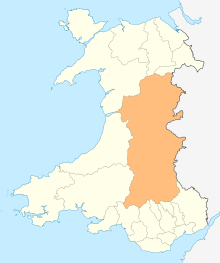Talgarth
Talgarth is a market town, community and electoral ward in southern Powys, Mid Wales, about 12 miles (19 km) north of Crickhowell. Notable buildings in the town include its 14th-century parish church and 13th-century Pele Tower,[2] located in the town centre, now home to the Tourist Information and Resource Centre. According to traditional accounts Talgarth was the capital of the early medieval Welsh Kingdom of Brycheiniog. It is in the historic county of Brecknockshire. In 2011 it had a population of 1,724.[3]
| Talgarth | |
|---|---|
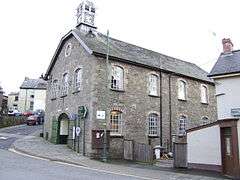 Talgarth Town Hall | |
 Talgarth Location within Powys | |
| Population | 1,724 (2011)[1] |
| OS grid reference | SO1533 |
| Community |
|
| Principal area | |
| Ceremonial county | |
| Country | Wales |
| Sovereign state | United Kingdom |
| Post town | BRECON |
| Postcode district | LD3 |
| Dialling code | 01874 |
| Police | Dyfed-Powys |
| Fire | Mid and West Wales |
| Ambulance | Welsh |
| UK Parliament |
|
| Senedd Cymru – Welsh Parliament |
|
Name
The meaning of the town's name is in the Welsh words tâl (forehead or brow of a hill) and garth (mountain ridge or promontory), thus "end of the ridge". It appears as Talgart in 1121, as Talgard after 1130, and in its present form in the years between 1203 and 1208.[4]
The church of Talgarth is recorded in 1488 as dedicated to Sce Wenne Virginis, explained as Gwen (granddaughter of Brychan), said to have been murdered by the Saxons.
Culture and community
In August, the Talgarth Festival of the Black Mountains is held, a popular countryside event which takes place each year. Talgarth Walking Festival[5] takes place every May, making use of the town's position at the foot of the Black Mountains. The town also has a dazzling annual Christmas lights display, organised by Talgarth Town Council and a team of volunteers.
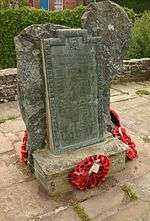
Talgarth held important links with healthcare for many years as the home of the large psychiatric hospital, the Mid Wales Hospital and the Mid and West Wales College of Nursing and Midwifery. Changes in health legislation in the 1980s saw the need for such hospitals to be closed. The Mid Wales Hospital closed for good in the 1990s. Since the early 2000s, regeneration efforts have been in place to support Talgarth's future[6]. It has since benefited from a new relief road[7], to remove trunk road traffic from its centre, allowing new businesses to open and buildings to be renovated and restored[8]. It's historic mill in the centre of town featured on the BBC's Village SOS[9] series and now attracts a new type of visitor to the area.
History
Roman period
The Romans were in this area and there was a Roman camp at "Y Gaer" near Brecon ( Aberyscir).
Indeed, the Romans were in this area and another Roman fort or station as sometimes these places were referred to has in recent years been found down river of Brecon and not so very far from Llangorse lake. Aerial reconnaissance discovered the outline of a yet un-excavated fort.
A Roman fort near Cwmdu (Pen-y-Gaer) is also of significance to Talgarth as there was a Roman route from Abergavenny via Pen-y-Gaer up the Rhiangoll valley to Talgarth, some experts say to Castell Collen near Llandrindod. Much evidence has been lost in the intervening 2000 years, but there is growing circumstantial evidence to suggest there is a missing Roman fort in the Talgarth area, at the crossroads of two or possibly three Roman routes, the Roman road from Pen-y-gaer, from Clyro to Y Gaer near Brecon and even the river Llynfi itself, although the latter may not be acceptable to some archaeologists. Nevertheless, water routes, even small ones are not unknown to have been used for man-hauling equipment in small, narrow flat bottom boats.[10]
The Dark Ages
Talgarth was the royal residence of Brychan King of Brycheiniog in the 5th century AD. With three wives, 24 daughters and 22 sons the family was an important force in Wales at that time. Responsible for the spread of Christianity throughout Brecknock, the daughters of Brychan and their descendants account for almost all of the saints of South Wales and include the grandmother of Saint David.
The Normans
The town (and Brycheiniog in general) was seized by the Norman Bernard of Neufmarché, who issued an undated charter concerning the district.[notes 1]
The town became part of Bernard's Lordship of Brecknock (a Marcher Lordship - an almost sovereign state). Castell Dinas was the initial site where a Norman castle was established by the Normans to control the passes on both sides. However, in the reign of King John, the then Lord fell out with the king, and the east of the Lordship was detached in punishment, forming a new Marcher Lordship of Blaenllynfi, ruled by someone else. Although the caput of the latter Lordship was officially Blaenllynfi Castle, Talgarth was its principal town, and the Lordship was often called The Lordship of Talgarth as a result.
The town was in the manor of English Talgarth, there being also a manor of Welsh Talgarth, in which Welsh laws prevailed. The Lordship of Blaenllynfi eventually found its way back to the descendants of the last Welsh princes of Brycheiniog (in the person of Rhys ap Hywel,[11][12][13] great-great-great grandfather of Sir Dafydd Gam).
Rhys played a significant part in the implementation (though not the planning) of the final coup against Edward II, and consequently Edward's son, Edward III, was not naturally well disposed towards him; the latter dispossessed Rhys' heir, and merged the Lordship of Blaenllynfi back into the Lordship of Brecknock (which, with the Lordship of Buellt, eventually became Brecknockshire, centuries later). The lands of the former lordship became a mere barony (of Talgarth).
The Welsh Jacobites
During the Jacobite revival support in Talgarth was strong. The town was a Jacobite hotspot, backing Bonnie Prince Charlie in his attempt to retake the Crown for the line of Stuart. In 1727 a meeting of local Jacobite sympathisers in Talgarth ended with members having to appear before a local magistrate to explain their actions.
During the Jacobite rising of 1745 Bonnie Prince Charlie had expected the Welsh Jacobites to offer support, but after Jacobite David Morgan from Penygraig, Quakers Yard was hung, drawn and quartered for treason, the Welsh feared persecution. The failure of the Welsh Jacobites to join the House of Stuart Prince in Derby was one of the main failures of the Jacobite uprising. [14]
The Methodist revival
In 1735 Talgarth saw the birth of the Welsh Methodist revival when Howel Harris, probably the most influential person to come from Talgarth, was converted in Talgarth church while listening to a sermon by the Rev. Pryce Davies. The revival would sweep across Wales leading to the development of one of the most influential Welsh denominations, that of the Calvinistic Methodists. It was at Talgarth that William Williams Pantycelyn converted, leading him to become one of Wales' most important hymn writers. Nearby is Trevecca, the location of the famous college that Harris established. Hywel Harris is buried in Talgarth at St Gwendoline's Church and his tombstone is still visible today. Talgrath is also thought to be the birthplace of the religious poet Jane Cave.[15]
Buildings and other sites of note
- Talgarth Mill
- Talgarth's Victorian Town Hall with its memorial clock tower overlooks the Square.
- The Medieval Tower House, also overlooking the Square
- The Tower Hotel was built in 1873 for the gentleman farmers to attend the livestock market, which still exists.
- St Gwendoline's Church, a grade II* listed building. (Saint Wenna (born c. 463) was a princess and a daughter of Brychan who founded the church of Talgarth and then evangelised parts of north Cornwall. She founded the church of St Wenn and chapels at St Kew and Cheristowe (in Stoke-by-Hartland, Devon). She died on 18 October, year unknown. Saint Gwendoline is a saint from the 8th century.)
- Nearby Bronllys Castle
Railway station
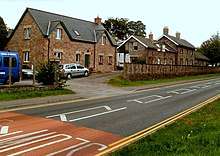
Talgarth also had a railway station on the Mid-Wales Railway which closed in 1962. The station was opened in 1864 concurrent with the opening of the Mid-Wales company line between Llanidloes and Talyllyn Junction; regular services started in September 1864 but special trains had run at the end of August.[16][17] It closed on 31 December 1962 when all lines to Brecon including the Mid-Wales line were closed.[18] The station buildings remain as private residence near the Rugby Ground and the old track bed is now incorporated into the A479 road.
Chambered tombs – Penyrwrlodd
A Neolithic chambered tomb at Penyrwrlodd, Talgarth (c. 4000 BC) was discovered in June 1972 by a farmer when clearing a stone mound from a field for use as hard-standing in the farmyard. The discovery led to archaeological excavation of the site by Dr Savory of the National Museum of Wales. During the excavation a number of human remains were found along with a bone flute, a human rib and some worked flints and stone. The bone flute was made from a sheep metapodial bone. It has three holes and may either have been a simple flute or whistle.[19] The larger hole may have been the blow-hole. This is the oldest dated musical instrument found from Wales.
Outdoor activities
Gliding
The Black Mountains Gliding Club is based on the hillside to the southeast of the town. It attracts many visitors from all of the UK, due to the year-round ability to remain airborne by means of mountain lift, both ridge lift and wave lift.[20][21]
Pony trekking
There are a number of riding operators in the area who hire out horses for both experienced and novice riders.
Walking
The Black Mountains above the town are used for upland hiking and hill-walking. The mountain ridges are around 2000 feet high with the highest point called Waun Fach at 811 metres (2,660 feet). A walking festival based on the town and its hinterland was established in 2013. The event attracts visitors at the start of May each year.[22]
Landscape and natural history
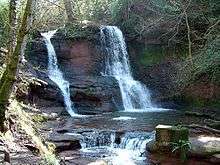
There is an ancient woodland along the banks of the River Ennig just 1 km from the town centre. There are a series of waterfalls within the wood. The largest is called Pwll-y-wrach, which means[23] 'Witch's Pool'. Local legend suggests that witches may have been ducked in this pool in medieval times. There is a geology trail, explaining the environment of 400 million years ago. A large part of Pwllwrach wood is a nature reserve, owned and managed by the Brecknock Wildlife Trust.
Site of Special Scientific Interest
Pwll-y-wrach wood is designated a Site of Special Scientific Interest (SSI) because of its special habitat values and the existence of some quite rare plants, including the small-leaved lime tree and the lesser butterfly-orchid. These are regarded as indicator plants of Ancient Woodland. That is an area that has retained a continuous cover of trees for thousands of years.
Geology
The fossil remains of ancient armoured fishes have been found in rocks within the late Silurian/early Devonian-age Lower Old Red Sandstone rocks exposed in local streamsides. Microscopic analysis has found fish scales and fin spines of these ancient fish some 410 million years old. The research carried out by a local man, Roderick Williams. The remains were then sent to Australia to a fossil fish expert Dr Sue Turner for photographing and finally a scientific paper was published on these findings. Within the area of Talgarth the geology requires more long term research as a rare spider-like fossil was found at Tredomen quarry and remains of very ancient plants from the same age rocks.
There is evidence of volcanic activity in the formation of air fall tuffs in the layers of rocks, blown out from a distant volcano. The nature of these tuffs infer an explosive type of eruption from volcanoes sited on the edge of a continental subduction zone. The whole area was probably tectonically unstable at the time.
There is some barytes present in rocks at Pwll-y-Wrach. There is a small source of lead ore at the Gospel Pass in the uppermost reaches of the River Honddu where strings of galena were found circa 1800. There was also an unsuccessful trial mine for copper at Felin Fach nearer Brecon in the 17th century. Some rather interesting ore mixture was found. There was further exploration in the 19th century when speculation was running high; a fallen-in shaft and tunnel still exists. Copper in the form of small green patches of malachite has been found in rocks at the base of a large mountain gully above Velindre. It is not known if this was exploited but the area has been referred to as the 'copper works' in a manuscript on beating the boundary of Llanigon parish.
Limestone in the form of 'calcrete' within the local sandstone rocks has been burnt for lime in many places across the Black Mountains for both lime mortar and agricultural uses.
Some years ago a local man interested in geology (R. B. Williams) found a thick tuff bed (20 cm or so thick) in the banks of the River Ennig not far above Penbont Bridge in the vicinity of Talgarth. It was instantly recognised as probably being part of the so-called Townsend Tuff Bed which has three distinct beds or layers in close proximity, known as layers A, B and C. A is the lowest bed and is recognised by coprolites on its upper surface; these may be the droppings of some unidentified crustacean. The finder had seen these beds at Cusop and Merbach Hill (Herefordshire) and they are widely known throughout the Old Red Sandstone of the Anglo-Welsh area by geologists. Recently concern was shown that this middle bed was at risk from the building of Talgarth's flood defences in the upper River Ennig. The British Geological Survey team was contacted by the finder of tuff bed B, and they were very interested in its location because recently the BGS (2011) had been working on the same rocks on the Epynt hills (artillery range). On visiting they decided that this thick tuff bed at Penbont was probably Bed B. Williams then showed them another known tuff bed which had been found by another local geologist Mr Hawley, placed at 'The Rocks' Talgarth just upstream of the mill. This was instantly recognised as Bed A. Bed C has yet to be found but the two geologists from the BGS are now considering resurveying the geology of Talgarth.
Flora and fauna
In spring the wood is carpeted with a succession of wildflowers leading to a mass display of bluebells in mid-spring followed by ramsons in late spring. The wood is home to the most important colony of dormouse in the region and some uncommon bats, including the lesser horseshoe bat. Other mammals found in the wood include badgers, foxes and otters along with birds such as tawny owls, dippers and pied flycatchers.
Governance

Talgarth has a Town Council representing the views of the community and has twelve community councillors.[24]
The Talgarth ward elects a county councillor to Powys County Council. Since May 2004 it had been represented by Liberal Democrat councillor, William Powell (who also sits on the Town Council). He was re-elected unopposed in 2008 and 2012[25] Powell was also elected as an Assembly Member of the National Assembly for Wales in May 2011.
| Party | Candidate | Votes | % | ± | |
|---|---|---|---|---|---|
| Liberal Democrats | William Denston Powell * | 520 | 82.9% | ||
| Labour | Ryan Dixon | 95 | 15.2% | ||
| Turnout | 627 | ||||
In media
Filming
A number of films and dramas have been filmed in and around Talgarth, notably On the Black Hill. Others include Morgan's Boy (BBC) a rare drama, now unavailable, Nuts and Bolts (ITV), where scenes were shot at the old hospital, and Hearts of Gold (ITV), where the town was assumed to be Pontypridd. Rhod Gilbert's 2009 DVD Rhod Gilbert and the Award-Winning Mince Pie was partly shot in Talgarth.
Books
Talgarth features as a location in Alfred Walter Stewart's 1931 novel The Boathouse Riddle, written under the pen name J. J. Connington. The boathouse which inspired Stewart was at nearby Llangorse Lake.
Town Twinning
![]()
Notes
- Bernard of Neufmarché's charter, due to poor 17th century publishing practice (the charter was included in the 1655 publication Monastican Anglicanum by Roger Dodsworth, amalgamated with another of Bernard's charters, the latter being dated 1088) and a Victorian marginal note (the charter re-appears with an added marginal gloss AD 1088 in the 1867 work Historia et cartularium Monasterii Sancti Petri Gloucestriae by William Hart) is now dated by some people to 1088.
References
- "Ward/Town population 2011". Retrieved 14 November 2015.
- Williams, Roger (1996). Talgarth-Jewel of the Black Mountains.
- Office for National Statistics
- http://www.cpat.org.uk/ycom/bbnp/talgarth.pdf Clwyd Powys Archaeological Trust: Historic Settlement Survey
- https://www.talgarthwalkingfestival.org/
- https://www.visittalgarth.co.uk/Talgarth-Information/tourist-information-and-resource-centre
- https://www.transportxtra.com/publications/local-transport-today/news/5348/a479-talgarth-relief-road-and-a438-bronllys-bypass-powys/
- http://www.ghostsigns.co.uk/2018/06/evans-jones-ricketts-restoration-in-talgarth-mid-wales/
- https://talgarthmill.com/watermill.html
- Raymond Selkirk, On the Trail of the Legions
- Calendar of Inquisitions Post Mortem: Volume 7, Edward III, File 14, entry 177
- Brecknock in S.Lewis, A Topographical Dictionary of Wales, London, 1849, online version
- John Burke, A Genealogical and Heraldic History of the Commoners of Great Britain and Ireland, 1833-37, Volume 3, entry for Price, of Castle Madog
- Isobel Grundy, ‘Cave , Jane (b. 1754/5, d. in or before 1813)’, Oxford Dictionary of National Biography, Oxford University Press, 2004 accessed 10 December 2015
- "Opening of the Mid-Wales Railway". Eddowe's Shrewsbury Journal. 22 (1, 145). 31 August 1864. p. 7 – via British Newspaper Archive.
- "Opening of the Mid-Wales Railway". Cardiff and Merthyr Guardian. XXXI (1715). 23 September 1864. p. 4 – via British Newspaper Archive.
- Mowat, C.L. (1971). "The Heyday of the British Railway system: Vanishing evidence and the historian's task". Journal of Transport History. Leicester University Press. 1 (1): 3.
- "Image of the Bone Flute from Penywyrlod". Item reference: 74.23H/6. Retrieved 25 July 2007.
- Black Mountains Gliding Club
- Talgarth gliding club:: OS grid SO1732 – Geograph British Isles – photograph every grid square!
- http://www.talgarthwalkingfestival.org/
-
- Morgan, Richard (1999). A study of Breconshire Place Names.
- "Town Councillors 2016 - 2017". Talgarth Town Council. Retrieved 21 January 2018.
- "Powys 1995-2012" (PDF). The Elections Centre. Retrieved 21 January 2018.
- "County Council Elections 2017 - Brecknockshire". Powys County Council. Retrieved 28 January 2018.
- https://talgarth.fyinetwork.co.uk/my,29972-TALGARTH-TOWN-TWINNING-ASSOCIATION
Bibliography
- Morgan, Richard (1999). A study of Breconshire Place Names. ISBN 0-86381-567-7.
- Remfry, Paul (2007). Castell Bwlch y Dinas and the families of Neufmarché, Hereford, Braose, Fitz Herbert, Mortimer and Talbot. ISBN 1-899376-79-8.
- Salter, Mike (2001). The Castles of Mid Wales. ISBN 1-871731-48-8.
- Williams, Roger (1996). Talgarth-Jewel of the Black Mountains. ISBN 1-874538-60-3.
